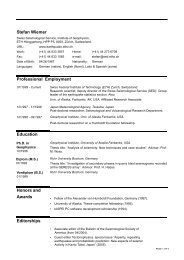zmap a tool for analyses of seismicity patterns typical applications ...
zmap a tool for analyses of seismicity patterns typical applications ...
zmap a tool for analyses of seismicity patterns typical applications ...
You also want an ePaper? Increase the reach of your titles
YUMPU automatically turns print PDFs into web optimized ePapers that Google loves.
#define VARIANCE_30 30<br />
change to:<br />
#define VARIANCE_30 90<br />
and re-compile (cc -o msiWindow_1 msiWindow_1.c)<br />
The cumulative misfit method<br />
Stress tensor inversions are time consuming, and the resulting tensor is not easily<br />
visualized. To identify crustal volumes that satisfy one homogeneous stress tensor Lu and<br />
Wyss (1995) and Wyss and Lu (1995) introduced the cumulative misfit method. The<br />
misfit, f, <strong>for</strong> each individual earthquake can be summed up in a number <strong>of</strong> different ways,<br />
<strong>for</strong> example along the strike <strong>of</strong> a fault or plate boundary. If the stress direction along<br />
strike is uni<strong>for</strong>ms within segments, but different from other segments, the cumulative<br />
misfit will show constant, but different slope <strong>for</strong> each segment (Figure 84). We can<br />
also study the cumulative misfit as a function <strong>of</strong> latitude, depth, time, or magnitude, and<br />
try to identify segments with constant but different slope.<br />
ZMAP allows taking the cumulative misfit method one step further: A grid (in map view<br />
or cross-section) is used, and the average misfit <strong>of</strong> the n closest earthquakes in<br />
an Euclidean sense is calculated. The distribution <strong>of</strong> this average misfit can be displayed<br />
using a color representation. Maps <strong>of</strong> this type, calculated <strong>for</strong> a number <strong>of</strong> different<br />
assumed homogeneous stress tensor can identify homogeneous volumes, which then can<br />
be inverted using the stress tensor inversion method described earlier.<br />
Figure 5.9. Schematic explanation <strong>of</strong> the cumulative misfit method. Changes in the slop <strong>of</strong> the cumulative<br />
misfit curve (blue) indicate a change in the stress regime. Figure courtesy <strong>of</strong> Zhong Lu<br />
49



